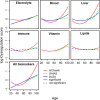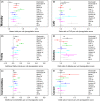Homeostatic dysregulation proceeds in parallel in multiple physiological systems
- PMID: 26416593
- PMCID: PMC4693454
- DOI: 10.1111/acel.12402
Homeostatic dysregulation proceeds in parallel in multiple physiological systems
Abstract
An increasing number of aging researchers believes that multi-system physiological dysregulation may be a key biological mechanism of aging, but evidence of this has been sparse. Here, we used biomarker data on nearly 33, 000 individuals from four large datasets to test for the presence of multi-system dysregulation. We grouped 37 biomarkers into six a priori groupings representing physiological systems (lipids, immune, oxygen transport, liver function, vitamins, and electrolytes), then calculated dysregulation scores for each system in each individual using statistical distance. Correlations among dysregulation levels across systems were generally weak but significant. Comparison of these results to dysregulation in arbitrary 'systems' generated by random grouping of biomarkers showed that a priori knowledge effectively distinguished the true systems in which dysregulation proceeds most independently. In other words, correlations among dysregulation levels were higher using arbitrary systems, indicating that only a priori systems identified distinct dysregulation processes. Additionally, dysregulation of most systems increased with age and significantly predicted multiple health outcomes including mortality, frailty, diabetes, heart disease, and number of chronic diseases. The six systems differed in how well their dysregulation scores predicted health outcomes and age. These findings present the first unequivocal demonstration of integrated multi-system physiological dysregulation during aging, demonstrating that physiological dysregulation proceeds neither as a single global process nor as a completely independent process in different systems, but rather as a set of system-specific processes likely linked through weak feedback effects. These processes--probably many more than the six measured here--are implicated in aging.
Keywords: aging; biomarker; homeostasis; multi-system dysregulation; physiology; statistical distance.
© 2015 The Authors. Aging Cell published by the Anatomical Society and John Wiley & Sons Ltd.
Figures




References
-
- Bender R, Lange S (2001) Adjusting for multiple testing—when and how? J. Clin. Epidemiol. 54, 343–349. - PubMed
-
- Cohen AA, Martin LB, Wingfield JC, McWilliams SR, Dunne JA (2012) Physiological regulatory networks: ecological roles and evolutionary constraints. Trends Ecol. Evol. 27, 428–435. - PubMed
Publication types
MeSH terms
Substances
Grants and funding
LinkOut - more resources
Full Text Sources
Other Literature Sources
Medical

